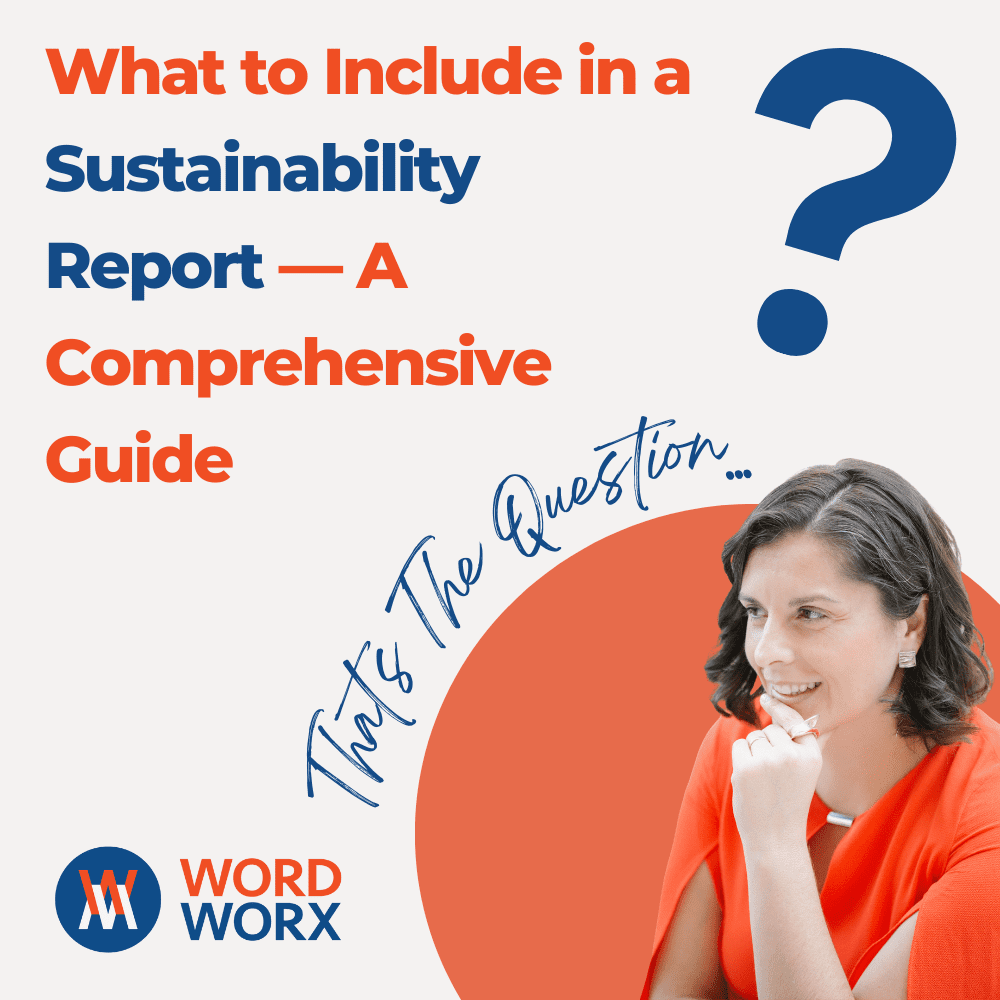If you have no idea what to include in a sustainability report, you’ve come to the right place. In this comprehensive guide below, I’ll outline what to add to your corporate report, ensuring your report stands out and effectively communicates your company’s sustainability efforts.
Before beginning to structure or lay out your report, make sure you define the report’s scope, boundaries, and reporting period and clarify this in the report’s introduction if need be. This can be done in an implicit manner within the text.
You can use the below headlines as an outline for your entire report, giving you a useful framework or structure to work with when writing.
What to Include in a Sustainability Report:
Table of Contents
The CEO Note or Executive Summary
Your Company’s Approach to Sustainability
Internal Regulations and Frameworks
Showcase Partner Organizations
The ‘Environment’ and ‘Social’ Sections
Conclude the Environmental and Social Sections
The CEO Note or Executive Summary
The CEO note or executive summary provides a high-level overview of your company’s dedication to sustainability and its strategic approach to addressing environmental and social challenges. It serves as a snapshot of your sustainability commitment for busy stakeholders. It also importantly serves as the introduction to the entire report. It’s the first thing people read, so you need to ensure this is impactful and catchy.
The ‘About Us’ Section
In this section, you can introduce your company, its mission, values, and how sustainability aligns with your overall business strategy. This section sets the context for your sustainability efforts. It need not be a generic section but should establish strong links to your company’s overarching values regarding sustainability.
The Governance Section
Here you can describe the governance structure of your sustainability efforts, including the roles and responsibilities of key stakeholders involved. This section underscores your company’s commitment to sound sustainability management.
Your Company’s Approach to Sustainability
Explain your company’s approach to sustainability in-depth, detailing the frameworks, principles, and policies guiding your sustainability strategy. This section highlights your commitment to integrating sustainability into your core business practices.
The Materiality Assessment
The ‘Materiality Assessment’ section explains the process of identifying material sustainability issues and how you prioritise them based on their significance to the company and stakeholders. This ensures that your report focuses on the most critical sustainability aspects. Here you can elaborate on both material issues of the sector/industry and topic issues (per the GRI framework for sustainability reporting).
Your Sustainability Roadmap
This section demonstrates your proactive approach to addressing sustainability challenges. Here you can present a clear and measurable sustainability roadmap outlining your short-term and long-term goals and the strategies to achieve them. I advise you to use a visual or graphic to demonstrate the roadmap instead of just text.
Compliance and Measurement
This section showcases how your company complies with relevant regulations and standards while providing performance metrics and key performance indicators (KPIs) to track progress. It reflects your commitment to being accountable and transparent in your sustainability reporting. Here you can also mention compliance with sector regulations or frameworks.
Internal Regulations and Frameworks
This section demonstrates your dedication to fostering a sustainable corporate culture. Here you can highlight any internal policies and procedures that promote sustainability within your organisation. Feel free to also add interviews with relevant internal stakeholders on the topic of regulations or frameworks.
Showcase Partner Organizations
Give credit to external partners, NGOs, or organisations collaborating with your company on sustainability projects. Highlighting these partnerships demonstrates your commitment to collaborative sustainability efforts. Many companies must pay more attention to this section in their sustainability reports — it can be a fundamental way to demonstrate your credibility and dedication to ESG topics.
The ‘Environment’ and ‘Social’ Sections
Understanding what to include in a sustainability report is crucial for any organization aiming to showcase its environmental efforts effectively. And when it comes to the ‘Environment’ section, you need to address your company’s environmental impacts and initiatives, while the ‘Social’ section should cover your social responsibilities and contributions to society. Added to this, companies must not only highlight their ‘social’ and ‘environmental’ achievements but also address challenges and areas for improvement in what they include in their sustainability report.
In my experience as a sustainability report writer, ensuring a human-centric focus to your report is imperative. This can easily be achieved through interviews and stories about sustainability initiatives/projects to be included in this section.
Conclude the Environmental and Social Sections
Summarise all mentioned in the ‘Environmental’ and ‘Social’ sections, the progress made, achievements, and future aspirations to continually improve your environmental and social performance. Include forward-looking statements demonstrating the company’s commitment to ESG in the coming years.
Details of DEI Policies
Describe your company’s commitment to diversity, equity, and inclusion (DEI) and any initiatives to foster an inclusive work environment. This can showcase your efforts to promote social responsibility within your organisation. Some companies include this information in the ‘Social’ section of the report (as mentioned above), whereas some opt to include a dedicated chapter on it; the choice is yours.
Concluding Remarks
End your sustainability report with concluding remarks emphasising your company’s dedication to sustainability and its importance in achieving a sustainable future. These closing thoughts leave a lasting impression on your readers, so choose your words wisely and always ensure you link back to the company’s values and mission when it comes to sustainability.
Acronyms and Appendices
Include a section explaining any acronyms used in the report to enhance clarity. Add relevant appendices to provide supplementary information, data, and case studies, making your report more comprehensive.
Summary of Our Guide on What to Include in a Sustainability Report
Remember that every sustainability report is different and can comprise different sections depending on your preferences. Knowing what to include in a sustainability report enables companies to align their environmental initiatives with broader global sustainability goals.
All-in-all, a well-structured sustainability report is a powerful communication tool for showcasing your company’s commitment to sustainability and responsible business practices. By including the above elements discussed in this guide, you can elevate your report’s visibility and impact, engaging stakeholders and fostering a more sustainable future for all.
If you have any questions about structuring your sustainability report or want to know more about what to include in a sustainability report, feel free to contact sustainability report writer Elizabeth Joss via email: info[AT]elizabethjoss. com.

